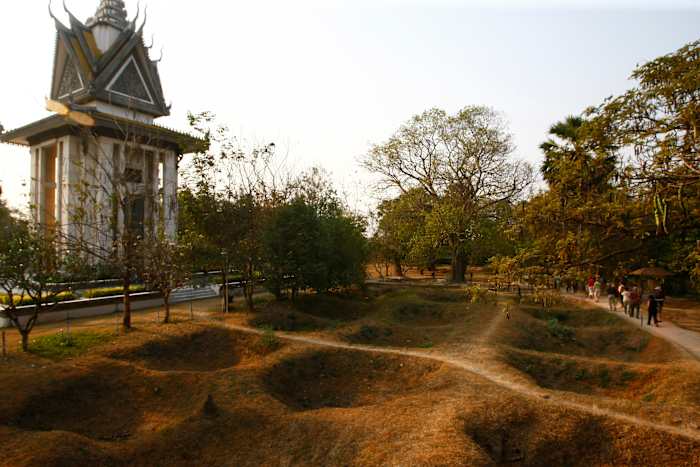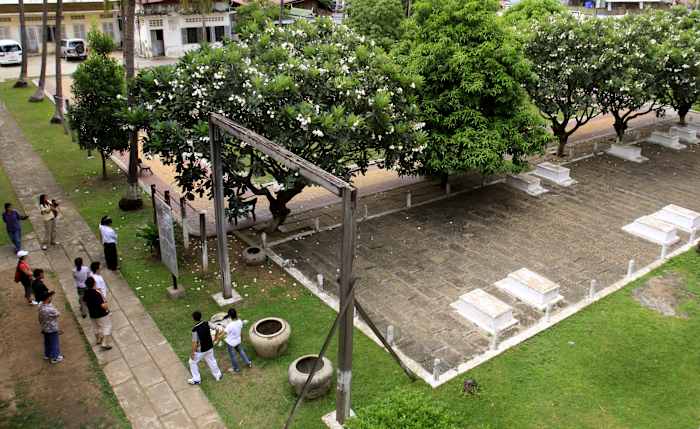Share this @internewscast.com

PHNOM PENH – UNESCO has added three sites to its World Heritage List that were once used by Cambodia’s harsh Khmer Rouge regime for torture and executions half a century ago.
These sites were officially included in the list by the United Nations cultural organization on Friday at the 47th Session of the World Heritage Committee held in Paris.
This recognition comes on the 50th anniversary of the Khmer Rouge government gaining power, a regime responsible for the deaths of around 1.7 million Cambodians due to starvation, torture, and mass killings during its brutal rule from 1975 to 1979.
UNESCO’s World Heritage List lists sites considered important to humanity and includes the Great Wall of China, the Pyramids of Giza in Egypt, the Taj Mahal in India and Cambodia’s Angkor archaeological complex.
The three sites listed Friday include two notorious prisons and an execution site immortalized in a Hollywood film.
Tuol Sleng Genocide Museum, located in the capital Phnom Penh, is the site of a former high school used by the Khmer Rouge as a notorious prison. Better known as S-21, about 15,000 people were imprisoned and tortured there.
The M-13 prison, located in rural Kampong Chhnang province in central Cambodia, also was regarded as one of the main prisons of the early Khmer Rouge.
Choeung Ek, located about 15 kilometers (10 miles) south of the capital, was used as an execution site and mass grave. The story of the atrocities committed there are the focus of the 1984 film “The Killing Fields,” based on the experiences of New York Times photojournalist Dith Pran and correspondent Sydney Schanberg.
The Khmer Rouge captured Phnom Penh on April 17, 1975, and immediately herded almost all the city’s residents into the countryside, where they were forced to toil in harsh conditions until 1979, when the regime was driven from power by an invasion from neighboring Vietnam.
In September 2022, the U.N.-backed Extraordinary Chambers in the Courts of Cambodia, better known as the Khmer Rouge tribunal, concluded its work compiling cases against Khmer Rouge leaders. The tribunal cost $337 million over 16 years but convicted just three men.
Cambodian Prime Minister Hun Manet issued a message Friday directing people to beat drums simultaneously across the country Sunday morning to mark the UNESCO listing.
“May this inscription serve as a lasting reminder that peace must always be defended,” Hun Manet said in a video message posted online. “From the darkest chapters of history, we can draw strength to build a better future for humanity.”
Youk Chhang, executive director of the Documentation Center of Cambodia in Phnom Penh, said the country is “still grappling with the painful legacies of genocide, torture, and mass atrocity.” But naming the three sites to the UNESCO list will play a role in educating younger generations of Cambodians and others worldwide.
“Though they were the landscape of violence, they too will and can contribute to heal the wounds inflicted during that era that have yet to heal,” he said.
The UNESCO inscription was Cambodia’s first nomination for a modern and non-classical archaeological site and is among the first in the world to be submitted as a site associated with recent conflict, Cambodia’s Ministry of Culture and Fine Arts said in a statement Friday.
Four Cambodian archaeological sites were previously inscribed as UNESCO World Heritage Sites including Angkor, Preah Vihear, Sambo Prei Kuk and Koh Ker, the ministry said.
Copyright 2025 The Associated Press. All rights reserved. This material may not be published, broadcast, rewritten or redistributed without permission.











